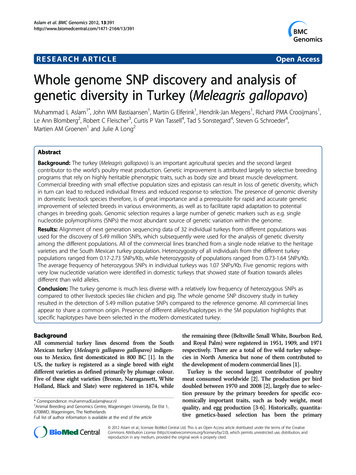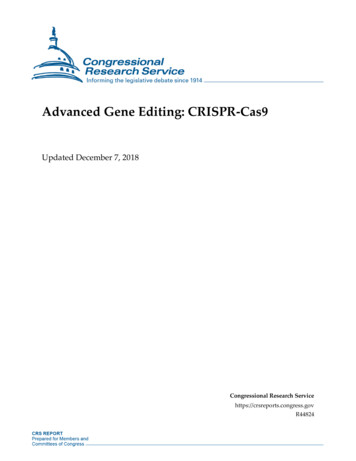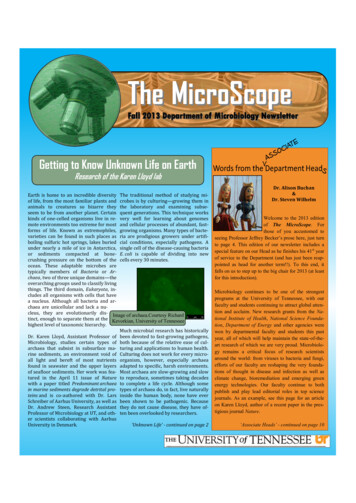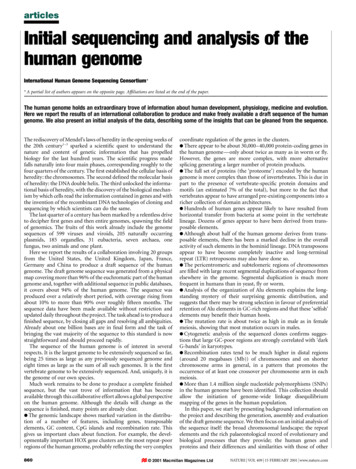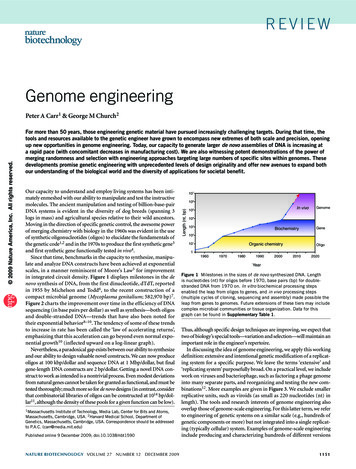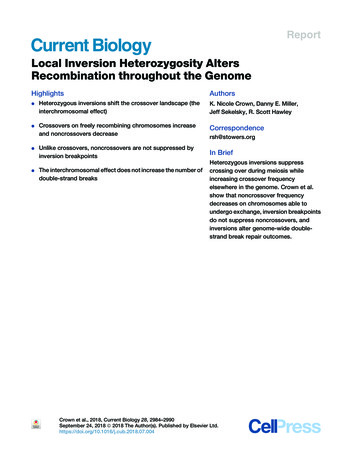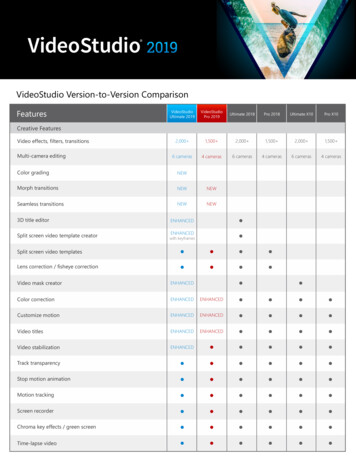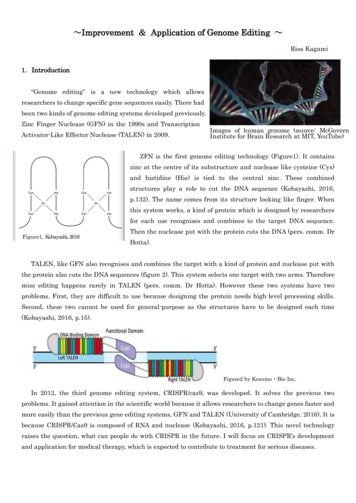
Transcription
Improvement & Application of Genome Editing Risa Kagami1.Introduction“Genome editing” is a new technology which allowsresearchers to change specific gene sequences easily. There hadbeen two kinds of genome editing systems developed previously,Zinc Finger Nuclease (GFN) in the 1990s and TranscriptionActivator-Like Effector Nuclease (TALEN) in 2009.Images of human genome (source: McGovernInstitute for Brain Research at MIT, YouTube)ZFN is the first genome editing technology (Figure1). It containszinc at the centre of its substructure and nuclease like cysteine (Cys)and histidine (His) is tied to the central zinc. These combinedstructures play a role to cut the DNA sequence (Kobayashi, 2016,p.132). The name comes from its structure looking like finger. Whenthis system works, a kind of protein which is designed by researchersfor each use recognises and combines to the target DNA sequence.Figure1, Kobayashi, 2016Then the nuclease put with the protein cuts the DNA (pers. comm. DrHotta).TALEN, like GFN also recognises and combines the target with a kind of protein and nuclease put withthe protein also cuts the DNA sequences (figure 2). This system selects one target with two arms. Thereforemiss editing happens rarely in TALEN (pers. comm. Dr Hotta). However these two systems have twoproblems. First, they are difficult to use because designing the protein needs high-level processing skills.Second, these two cannot be used for general-purpose as the structures have to be designed each time(Kobayashi, 2016, p.15).Figure2 by Kosumo・Bio Inc.In 2012, the third genome editing system, CRISPR/cas9, was developed. It solves the previous twoproblems. It gained attention in the scientific world because it allows researchers to change genes faster andmore easily than the previous gene editing systems, GFN and TALEN (University of Cambridge, 2016). It isbecause CRISPR/Cas9 is composed of RNA and nuclease (Kobayashi, 2016, p.121). This novel technologyraises the question, what can people do with CRISPR in the future. I will focus on CRISPR’s developmentand application for medical therapy, which is expected to contribute to treatment for serious diseases.
2.Literature ReviewThere has been a lot of research on genome editing.Many books and articles have been published and there isincreasing attention on the subject, for example, thepossibility to apply for medical treatment, agriculture, and anatural resource.Genetic recombination is a way of recombining genes bydamaging them from outside of the cells and expectingmutations to be caused (Kobayashi, 2016, p.105). This wascommonly used to change genomes once, but it succeedsrarely and the outcome of which gene sequence is changed isuncertain (NHK Publisher, 2016, p.18). Researchers workedto create a new way to change genomes easily, fast andreliably. As noted previously, in the 1990s, the om)technology for genome editing, Zinc Finger Nuclease (ZFN) was developed. In 2009, the second genomeediting technology TALEN was developed (Kobayashi, 2016, p.18). These two technologies have a problem inthat they are difficult to use because they utilize protein. In addition, these two are not adapted to use ondifferent species of animals. For example, a sacksful TALEN genome edit made for mice cannot be used forother animals. Finally, in 2012, the third genome editing system, CRISPR/Cas9, which uses guide RNA andnuclease, was created. This system overcomes the previous technical problems and allows researchers tochange genes like editing sentences (Kobayashi, 2016, p.14). The user only has to design the guide RNA tomatch the target order of DNA, and put it with Cas9, a kind of enzyme acting like scissors for DNA(Kobayashi, 2016, p.120), into the cells then the two materials edit the genome, as Figure3 shows. Cas9exists in nature such as inside some bacteria. Also, it can work with any guide RNA sequences. ThereforeCRISPR/Cas9 system can be used for several species withoutaltering every time.There are, however, still some problems with the technology,safety and ethical concerns with CRISPR. This system is not 100%accurate and therefore, sometimes, unexpected mutations happen,called “off-target effects”. The rate of these has been decreasingthanks to the efforts of scientists, but concerns still remain,especially with regards to medical applications for humans (NHKPublisher, 2016. P106). There is discussion among both ordinarypeople and researchers about whether genome-edited food is safe toeat. This will be important when attempts to edit the genome offoods, such as creating fish with more muscle and drug-resistantcrops, progress. Ethically, it could allow people to make designerbabies in the future. The border between medical therapy anddesigner babies is a source of debate. Discussion on this subject isbadly needed.Currently, several researchers in gene editing are making progressFigure4: Development of three types oftreatments for Muscular Dystrophy(Xu, Hotta, 2016)
in medical areas. They are trying to treat serious diseases like AIDS, Muscular Dystrophy and even cancerwith gene editing. A clinical experiment on the treatment of AIDS is underway in America (NHK Publisher,2016, P.95). In the Center for iPS cell Research and Application, Kyoto University (CiRA), some researchteams are trying to treat the symptoms of Muscular Dystrophy by injecting genome-editing chemicals intothe patients’ muscle (pers. comm. Prof. Hotta and Dr Takenaka). They think there are three ways to achievethis goal, deleting some parts of the relative genes, shifting the reading frame of the relative genes, andinserting genes to appropriate parts of the relevant genes (Figure4). The first one is thought of the mostpractical (pers. comm. Dr Hotta). Now there are several approaches to cancer research using genome editing,for instance, recognising the cause of cancer and stopping itsprogress with genome editing.Also, genome editing is used in agriculture, for example,allowing bigger plants to be made, vegetables without poisons tobe produced, and animals and fish to be bred with more muscle.An example of a unique application of genome editing is from Prof.Harayama in Chuo University who is trying to make algae whichcan be a fuel, like oil (NHK Publisher, 2016, P.91). The potential isimmeasurable.3.MethodogyThe studies on gene editing above raised a number of questions and interesting ideas. To answer these,two researchers at CiRA and six researchers at the University of Cambridge were visited and interviewedabout the development and application of genome editing.Four main research questions were made, below, alongside follow-on questions.The main questions are:1) Which method is the best, most efficient, or safest to apply gene editing to the medical field, bymedicine, cell therapy or genetic therapy?2) Do many parts of the genome whose roles are not known affect the outcome and probability of off-targetresults? Can we continue to use genome editing technologies even in the situation where gene functionis unknown?3) Why is there no success in genome editing experiments on human fertilized eggs (a research team inChina failed in such experiments in 2014)? Some research teams have already succeeded inexperiments on some kinds of ape. So are human eggs quite different from other apes’ eggs?4) How can the ethical problems of gene editing or transplantation be overcome? What do you think aboutconcerns over the safety of gene edited food?Through the preliminary research, it is possible to make predictions, below, and discuss them during theinterview.The predictions are:1) That combining gene editing and stem cells can be the best way to apply this technology to the medicalfield.
2) The core site of serious diseases can be treated with genome edited cells by cell injection or othersimilar methods in the future.The people interviewed were:・Dr Nana Takenaka, a researcher of Sakurai lab at CiRA・Junior Associate Professor Akitsu Hotta, a Principal Investigator at CiRA・Prof Ludovic Vallier, a professor of department of surgery at CambridgePicture1・Dr Shota Nakanoh, a researcher of departmentof surgery at Cambridge・Dr Kim Jee Goh, a researcher of department ofsurgery at CambridgePicture3・Prof Allan Bradley, a professor of CambridgeStem Cell Institute4. ResultFrom the interviews, the following points were raised.Picture2・Prof Roger Barker, a professor of BrainRepair Centre of CambridgePicuture4・Dr Stefano Pluchino, a doctor of department ofneuroscience at Cambridge
A. Re: the research questions1) Which method is the best, most efficient, or safest to apply gene editing to the medical field, by medicine,cell therapy or genetic therapy?A. Cell therapy in vitro (outside of body).Why? The genome-edited cells can be screened before they are placed into a patients’ body. Therefore therisk of off-target or other errors are reduced (pers. comm. Prof. Barker).2) Do many parts of the genome whose roles are not known affect the outcome and probability of off-targetresults? Can we continue to use genome editing technologies even in the situation where gene function isunknown?A. Yes (both of the questions above).Additional information It is really difficult to reduce off-target effects and it is a fact that unclear parts ofthe genome affect off-target results very much. Now researchers use software developed to design the guideRNA. To reduce off-target effects, targeting unique DNA sequences is a good method because the CRISPRsystem sometimes cuts a different sequence which has a similar DNA order. Their software helpsresearchers to find unique sequences in the genome. Using such software can reduce off-target effects, butthey can still happen. This is why researchers have to be careful. A co-worker of Dr Nakanoh is trying tostructure the Cas9 of a protein to reduce off-target effects. Since Cas9 is an enzyme found in naturalcreatures, it contains nucleic acid (pers. comm. Dr Nakanoh). Therefore, very rarely it is taken into the DNAsequences that researchers try to edit. It is said to be one of the causes of off-target effect. This developmentcan contribute to reducing the off-target effect.(Figure6)Sometimes there is difficulty in recognizing what happened inside the cells after genome editing becausethe change might happen somewhere unknown or unexpected (pers. comm. Dr Hotta). For example, aresearch team at Tsukuba University found a gene related to sleep by chance. Originally, they tried torecognize another gene’s function, but they failed. This success happened thanks to their careful observation(pers. comm. Dr Hotta).
(Figure7, After Hotta, 2015)It is important to reveal such parts of a gene sequences’ role by genome editing technology and it is veryvaluable in other biotechnology applications. For this reason, the combination of genome editing andmysterious genes is not always negative.Dr Takenaka spoke of her experience of genome editing. She has edited 24 cells’ genomes in a part of herstudy, but she succeeded perfectly on only one cell. The failures had either the wrong genes edited or noresult. This failure is not only an off-target result but also left an unedited genome. This rate of success canseem to be low, but such results are common knowledge among researchers in this field.3) Why is there no success in genome editing experiments on human fertilized eggs? Are human eggs quitedifferent from other apes’ eggs?A. Researchers think there were two problems in the study which failed to edit the genome of fertilizedhuman eggs: sample size and egg quality (pers. comm. all of the interviewed researchers). It is no moredifficult to handle human cells than any other animal cells, consequently humans are not different fromother animals regarding genome editing systems (pers. comm. Dr Hotta). For sample size, 85 eggs were used,but they could not edit the genome as they wanted on any eggs (Kobayashi, 2016, p.21). According toresearchers, such a success rate when genome editing can happen for any animals’ fertilized eggs (pers.comm. Dr Hotta, Prof. Bradley). Since the object was a human cell, the media said the success rate was toolow. Of course it is currently not good enough to apply to human medical therapy, but no researchers Iinterviewed think the technique is fully developed. This news is not relevant long-term as scientists willlearn more about this technology and the mystery of the genome. For the problems with egg quality, theresearch team used fertilized eggs that did not grow into an embryo and contained multiple sperm each(Kobayashi, 2016, p.20). They explained that, ‘It was because the aim was only to measure the probability ofgenome editing on human fertilized eggs’ (Kobayashi, 2016, P.24). Researchers think these kinds of eggsmight be weak or lower quality in some ways than others, so this is one of the reasons for the failure.4) How can the ethical problems of gene editing or transplantation be overcome? What do you think aboutconcerns over the safety of gene edited food?A. The answers to this question varied depending on the person, but all thought that they have toovercome such ethical problems and safety concerns to develop medical therapy with genome editing.The answers:・Dr Takenaka said, ‘as a researcher, I do not think genome-edited food is dangerous to eat, but I am not sure
if I would allow my child to eat them as a mother. Many of my friends who are mothers and researchers herehave the same opinion.’・Junior Associate Professor Hotta said gene-edited food is safe because there are many mutations withsudden genome changes in nature. Also, to continue explaining the risks and benefits of genome editing,people can get a general understanding of genome editing, he thinks. The ethical department at CiRA playsthis role. This kind of department is rare in Japan.・Prof. Ludovic mentioned that this new technology is a great tool but we have to improve it first. We shouldnot hurry more than is needed and forget that only a little is known of the genome.・Prof. Bradley said that stem cells are good enough to overcome the ethical problems except in the case ofthe ES cell which is made by killing an embryo. In addition, we have to limit the use of genome editing forhumans to prevent the development of dangerous techniques with unexpected consequences. He also thinksgenome edited food is safe. Prof. Bradley also said that the “on-target effect” is much more dangerous thanoff-target results because what is happening inside the cells may be unknown as only the surfaceconsequences are visible. If a genome can be edited at will, the safety is unclear.(Figure8)・Dr Pluchino tried to overcome the ethical problems on his study by using direct inducible cells (notinducible pluripotent stem cells) which are made from human skin cells and turning them into human nervecells. Recently, this kind of system has been developed by researchers.B. Predictions1) Can combining genome editing and stem cells be the best way to apply this technology to the medicalfield?A. These two technologies have great potential so many researchers have been trying to improvebiotechnology with this combination. However Prof. Barker cautioned not to confuse these two becauseoriginally they were completely different tools. Each of them has a lot of potential singularly and there arestill many problems that can be solved by each.2) Can the core site of serious diseases be attacked with genome edited cells by cell injection or other similarmethods in the future?A. Dr Hotta, who studies genome editing and iPS cells said such therapy would be great, but it hasdifficulty delivering factors or medicine to treat the target on purpose. On the other hand, Dr Pluchino, whostudies cell injection, thinks such a direct way can be developed using cell injection as a vector againstillnesses attacking in the body.
C. OthersDuring the interview, I asked some specific questions about the researchers’ field of study. Their answersfollow below:1) Prof. Vallier and his team developed the enhanced CRISPR system, which allows researchers to switchmultiple specific genes’ expression on and off whenever they like while the cell is growing. It makesscientists able to investigate the role of whole families of related genes by reducing the activity of the genesto focus on specific gene’s functions. However the preparation for this system takes from two to three weekseach time, which may be too long to be viable.Consequently I asked: Is this length of preparation too long or not a problem?A. It is a little long for researchers but not so long as it becomes a problem. It is because stem cellsoriginally take 5 to 6 months to grow into differentiated types. The researchers who usually handle cells feelthat experiments with stem cells are like growing babies since they need a great deal of care and time. Ofcourse they feel it is hard to do that and shorter time with fewer steps is better, but they do not require theseadvances urgently.2) Prof. Barker seemed to focus on how to assess the treatment, so I asked “what do you pay attention inorder to assess the treatments?”A. He told me that when he assesses the efficacy of a new treatment in his research, he wants to see howthe factor works in the brain by a scan. However it is difficult. It is challenge for scientists in the field ofbrain repair. Moreover it is better to observe the long-term results on brain repair. So it needs a long time tocollect results.3) Prof. Bradley has discovered new roles for the many genes by knockout mice, mice whose genome has hadspecific genes edited by researchers to observe the function of the genes, and provided open access to thedata. I asked, ‘do you think you can completely reveal all roles for each gene?’A. Eventually. However, now they can look at the surface of the gene’s function though the genes workmore deeply in our bodies. We should understand more about the genome.(Figure9)4) Prof. Pluchino studies cell injection technology. I asked, can cell injection be used as a tool for celltransplant?A. Yes, it can be used to transplant clinically. The proportion of stable cells in the target is small, but thereis long-term research on cell transplantation by cell injection.
5. DiscussionIn applying the results and the interviews to the research questions, it seems that:A. Re: the Research Questions1) The best way to apply genome editing for medial application is therapy in vitro.I had believed that cell therapy in vitro is the safest approach but the ideal is something in vivo (inside ofthe body) because it seemed more efficient. However, in fact, researchers do not think the benefit of in-vivotherapy is so much great because the theory of cell transplanting is established. Therefore cell therapy invitro is the best way to apply genome editing for medical treatments, I think.2) The unclear parts of the genome can affect the result of genome editing experiments.There is concern about some effects of unclear parts of the genome, researchers agree this is a problem.This is one of the biggest issues that researchers face every day. Even if more and more studies and clinicalexperiments make progress, it is impossible to solve this problem completely. Effort to reduce concern isbadly needed, but perfect treatment is most likely unrealizable. Thinking in terms of “risk and benefit” isessential for researchers and patients (pers. comm. Prof. Bradley). In terms of the effort needed, it includesadvancement of the software to design guide RNA and attempts to structure the Cas9 protein.In fact, there are several researchers trying to discover gene functions by genome editing and sometimesit is useful in recognizing the causes of serious diseases like cancer. This kind of usage of genome editingmost likely has fewer concerns about off-target effects than studies of medical treatment for humansbecause such failures might induce new discoveries. So I believe that these kinds of studies should progressmore in the near future. It can contribute to a better understanding of the genome and vitality.(Figure10)3) The reason why the attempt of Chinese research team could not succeed in editing human fertilized eggs’genomes is that there must have been a problem with the egg quality and the sample size.In this case, my prediction was right because I was wondering whether the fertilized eggs in theexperiment, which have multiple sperms in each of them and never grow into embryos, can exist after theediting of the genome with a small sample size of only 85 eggs. However, I also shocked by the practicalsense among researchers of this field, where to have the probability of a perfect success in genome editing isquite low. It is natural to have no success in 85 samples. I am sure that few people think this is high enoughto apply to humans. This is one of the reasons why most of the researchers do not hurry to apply thetechniques to humans for medical treatment. I strongly believe the media should tell ordinary people about
this kind of information.4) There are multiple ways to overcome the ethical issues of genome editing.I remembered three important aspects from the answers to this question. First, ethical and safetyproblems of research are serious issues for researchers and they have difficulty in making progress instudies with explaining complex information to people and trying to improve their experiments. In fact,there has already held an international conference by researchers to discuss such issues (NHK Publisher,2016, p.123). It shows their high-level of ethical commitment. Second, I was sure of the importance of the“iPS cell” because many researchers use it for their research. Several researchers said that iPS cells havethe possibility to overcome ethical problems with ES cells, which are made by killing embryos, because iPScells are made from differentiated cells and no embryos die. It is true that we should discover the potential ofeach technology, genome editing and pluripotent cells, but the combination of these may contribute to thefield of medical science greatly. Third, scientific studies are related to each other in many ways. For example,Dr Pluchino uses a new system to turn skin cells into neuron cells for his experiments to overcome theethical problems and shorten the preparation time. Wide fields of studies are developing which influenceeach other.B. Re: the Predictions1) Combining gene editing and stem cells can be the best way to apply this technology to the medical field.Although there are many articles which combine pluripotent stem cells and genome editing (Kobayashi,2016, p.5), the two technologies are quite different and should be studied separately. However, someresearchers actually pay attention to combining these two, and the media also focus on that. Therefore, bothkinds of research should progress. In the future, I hope for some great discoveries in each field, theseparated areas of research of genome editing and stem cells can be put together and may make an amazingmethod.On the other hand, I feel that there might be the need for some novel system to apply to genome editing.There are still limitations where genome editing can be used by itself. Advancement of new technologyseems to be needed.2) The core site of serious diseases can be attacked with genome edited cells by cell injection or othersimilar methods in the future.I was happy to get a positive response to my prediction. I could find a new possibility to connectseparated fields. Dr Pluchino said that cell injection works as just a vector. I believe there needs to bevectors working in vivo, because there are many technologies for controlling and observing cells insideanimals on prepared slides, or grown in vitro. However, there is often difficulty taking them in vivo and thisskill is necessary for use in a clinical environment. I expect this kind of skill will be developed in the future.C. Others1) The length for preparation of enhanced CRISPR system is a little long for researchers but not so long as itbecomes a problem.
I was convinced by the statement of the researchers, ‘experiments with stem cells are like growing ababy’. I got a strong impression that they seemed to enjoy taking care of the cells even though it is hard.Anyway I was surprised at the length of time research using stem cells took. I hope it will be shortened inthe future. This experience reminds me of the care needed involving research with creatures.2) Prof. Barker wants to see how the factor works in the brain using scans to assess any new treatments.Brain repair techniques have garnered a lot of attention in the scientific world. However, since the brainis difficult to observe, sometimes the data is unclear. This should be solved as quickly as possible. On theother hand, they collect long term results to look at the efficacy of the treatment. I wonder if the difference inmental situations of the patients might affect the result a little. Many fields like psychology study theenvironment and of course brain repair seems related to this field (pers. comm. Prof. Barker). I think theyshould be combined to consider the result.3) Prof. Bradley believes that he can eventually completely discover all roles for each gene.It would be amazing if this can come true in the future. It will contribute to a wide range of study.However, he cautions that now they only recognize the surface of a gene’s functions and the deep mechanismis unclear. This should be emphasized greatly. If someone loses this awareness, they might make seriousmistakes in their observation of experiments. I hope there will be an understanding of deep functions of thegenes. To achieve this can lead new discoveries.4) Dr. Pluchino said that cell injection can be used to help transplants in clinical medicine.From this answer, I recognized a new possibility of treatments with transplantation because there aremany people who hesitate to receive direct transplantation into the body, but they have less hesitation aboutinjection into their body. If cell injection technology will become established, the mental stress of suchpatients might be decreased. It means that combination of cell injection and genome editing or stem cellscan contribute to improvement of medical treatment with transplantation as I expected.Then I got a new prediction about the efficacy of this transplantation. In fact, it is the same as therapywith medicine that injected cells to treat illness diffuses widely inside a patient’s body, and whenresearchers tried to treat serious illness by medicines to edit genome, the attempts was failed because themedicines could not stay in specific points for a long time. So I am afraid that cell injection does not work soefficiently as normal transplantation because of the same reason as the attempts with medicines to editgenome. This is my new prediction.D. Overview of the ResearchThrough this research the techniques, ethics,safety and the difference between media stories andthe researchers’ opinions all proved to be important.As for the result above, CRISPR or other genomeediting is an amazing tool for researchers, but still(Figure11)not perfect. The concerns and risks outweigh thebenefits for many researchers if the usage of genome editing was expanded. Though the media cover genome
editing as a dream technology, like all new technologies, it needs much study and improvement. Kobayashisaid, “The UK is historically not afraid of the taboo, like designer babies, so they are making progress onresearch of genome editing now.” Actually this statement is inaccurate. The researchers I met in the UKunderstand the “risk and benefit” of genome editing very much. Therefore they know we have to study moreabout this new technology. This fact makes for a large volume and high speed of study, even using humancells, in the UK. It is one such example that shows the UK is a reaching country in science. For the ethicalproblems, ordinary people think it a complex topic, so researchers are seriously worried. The safety ofgenome edited food is controversial, moreover even researchers do not know where the limit of genomeediting lies with regards to ethical concerns. It made a strong impression that one researcher has differentopinions as a professional and a mother.There is a long way for a new technology to develop to help people. This experience showed me thedifficulty in studying. Researchers’ views on the ethical problems are also very interesting because these arenot covered often in the literature.For the predictions, I was surprised that the answer was, “possibly.” Most of the time, researchers hadalready considered my ideas, but they answered the questions seriously. Science seems much closer toordinary people than before.6. ConclusionAll the people interviewed at Cambridge were so kind and I provided a wonderful experience with manygreat answers. I was surprised at the attitude of the researchers, welcoming a high school student like me. Iwas impressed with the fact that there were many persons using cells on their study, even though it was inthe middle of summer vacation season I visited there. I learned the difficulty of research they face every day.They have to try not only to improve their research, but also to make people understand. I also found thatresearch is more developed than ordinary people think because there are many unpublished topics whichare under way. I became even more interested in scientific research.7. Bibliography / Reference・Kobayashi Masakazu, 2016, ゲノム編集とは何か―「DNA のメス」クリスパーの衝撃・NHK Publisher, 2016, ゲノム編集の衝撃 uaigeng Xu・Akitsu Hotta, 2016,医学のあゆみ Vol.259 No.1『Genome editing strategy for Duchennemuscular dystrophy』・Akitsu Hotta, 2015, 医学のあゆみ Vol.252 No.2 『Genome engineering technologies to accelerate theapplication of iPS cells』・Ludovic Vallier, 2016, Optimized inducible shRNA and CRISPR /Cas9 platforms for in vit
Risa Kagami 1.Introduction "Genome editing" is a new technology which allows researchers to change specific gene sequences easily. There had been two kinds of genome editing systems developed previously, . Now researchers use software developed to design the guide RNA. To reduce off-target effects, targeting unique DNA sequences is a .
